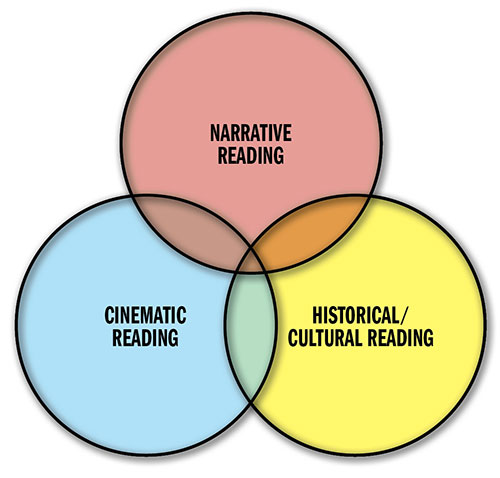Why is cinema literacy important?
Movies are more than just entertainment. They’re a door to knowledge. Knowledge of art, history, society. Knowledge of ourselves.
The language of film is a uniquely persuasive one. Communication using moving images is everywhere. Critical-viewing is as essential a skill as critical-thinking.
The language of film is universal. Movies enable us to see the world through another’s eyes.
Films are representations of our culture through time. They communicate ideas and feelings, fears and aspirations.
Complementing Common Core Standards
The Story of Movies supports the Common Core’s emphasis on deep learning. Today’s students are asked to recognize, understand and appreciate content in diverse media and formats. Cinema literacy requires students to use inference and implicit information to derive meaning.
An interdisciplinary approach
The scope and sequence of The Story of Movies lessons and activities integrate language arts, history, social studies, music, art and science. Students tap their existing knowledge to interpret and derive meaning from films, and cross-curricular links deepen their understanding of these subjects.
Why teach The Story of Movies?
Film is a communications medium and an art form, worthy of close reading and serious discussion. The Story of Movies curriculum challenges teachers and students to explore in-depth this essential part of our history and culture.
Reading a film on multiple levels
To provide the depth and complexity expected in the 21st century classroom, The Story of Movies teaches students how to read a film on three different levels:

Narrative reading. What is the story about? Who are the characters? What are their conflicts? What happens?
Students learn to infer meaning by reading the images and sounds.
Cinematic reading. How is the story told? Students learn to identify and interpret cinematic devices and elements of style. They analyze framing and composition, lighting, camera angles and distances, juxtaposition of images, pacing, movement, and sound. Students evaluate and critique films as they would other works of art, through in-depth study, comparing/contrasting and discovering connections.
Historical/Cultural Reading. What does the story mean? Students study the context within which the film was made. They explore the social issues relevant to a film’s theme, the ways in which the film reflects and possibly influences its time. Students learn to decode a film’s ideological orientation, and consider how the meaning changes when viewed from a contemporary perspective.
